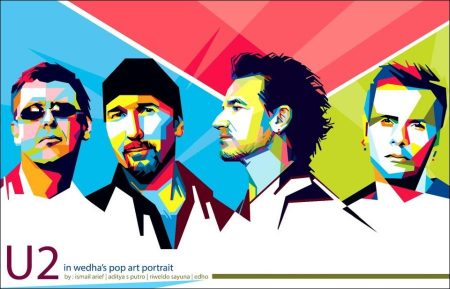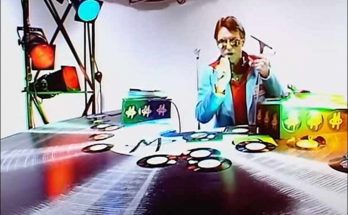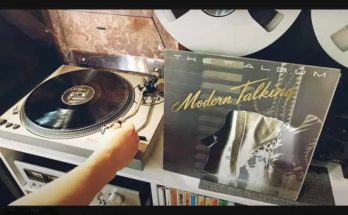Recording is over. The album, the producer says with theatrical flourish, is a wrap. But this, in many ways, is only the beginning.
Sometimes what’s been completed is more than a few brush strokes short of a masterpiece. Something that you then have to spend countless hours bigging up in interviews, and many more playing to fans across the world (if you’re lucky).
Belle & Sebastien’s Stuart Murdoch was rather sniffy to BBC Music about the band’s much-feted second album If You’re Feeling Sinister, which the band performed in its entirety at the Pitchfork Music Festival in Chicago. He’s not the first artist to become less than enthusiastic about an album. Here, BBC Music looks at a raft of other albums disowned by their creators.
U2 – Pop (1997)
The early 1990s saw the band casting out the cowboy boots and widescreen stadium-friendly Americana for mitteleuropean ennui and disturbing sunglasses. After taking cues from the likes of the Pixies and Ride, the band were riding a wave of commercial and critical richness. That experimentation hit the buffers, somewhat, with Pop.
The album that spawned the Popmart world tour struggled to emerge out of the studio. Drummer Larry Mullen had to have back surgery as the sessions started, putting the band behind schedule. The band then spent three months trying to corral a mass of musical fragments into a coherent album along with producers Flood, Howie B and Nellee Hooper. Songs were constantly reworked. Unhelpfully, U2 had booked stadium dates for their new tour from April 1997, despite the album not being finished yet.
Bono only recorded the chorus to one song – Last Night On Earth – on the final day of mixing and recording, and further changes were made even after the “finished” record had been sent to New York to be mastered. The album’s rushed production meant U2 were less than happy with the album’s songs. They reworked them during the tour, and were still tweaking singles when a few of them made the compilation The Best Of 1990-2000, five years after the album was released.
“Pop never had the chance to be properly finished,” Bono related after the fact. “It is really the most expensive demo session in the history of music.”
The Clash – Cut The Crap (1985)
The Clash’s sixth-and-last album not only spelled the end of their careers, it almost destroyed their legacy as well. By the time the Clash came to record it, two of the Last Gang In Town had been summarily fired: drummer Topper Headon and guitarist and co-vocalist Mick Jones. Frontman Joe Strummer reunited with the band’s original manager Bernie Rhodes, a union that had caused chaos in the band; this time, Rhodes wanted to co-write the songs and produce the album. Strummer and bass player Paul Simonon were joined by session musicians, with Strummer and Rhodes clashing more and more over the direction the album should take.
Cut The Crap was a mess, and a career-ending one at that. Rhodes’ inexperience as a producer meant the album was cluttered with unnecessary guitar parts and football-terrace vocals. The album was received so badly that the band refused to tour in support of it. Strummer, appalled by the negative press, moved to Spain. The band’s last album has never been re-released, and its songs rarely crop up on Clash compilations.
Van Halen – Van Halen III (1998)
Van Halen were one of the most over-the-top hair-metal bands of the 1980s, fronted by the larger-than-cartoon-life David Lee Roth. Roth bailed first in the mid-80s, in favour of a solo career, leaving Sammy Hagar to handle vocal duties. That lasted until 1996. After a short-lived and acrimonious reunion with Roth, Van Halen then enlisted former Extreme singer Gary Cherone to take over the mike.
The resulting album – Van Halen III – was produced by Mike Post, the composer behind TV show themes such as The Greatest American Hero and Hill Street Blues. The resulting songs rivalled Oasis’ Be Here Now for bloated length; the closing track How Many Say I is a six-minute-long piano ballad.
The album sold poorly, and a follow-up died in the studio, leading to Cherone’s exit. When Van Halen got around to producing a best-of album in 2004, The Best Of Both Worlds, not a single track from Van Halen III appeared on it.
The Smiths – The Smiths (1984)
The debut album from the British indie pioneers didn’t arrive easily; the band initially recorded it in an east London basement during a heatwave in 1983. The heat was so intense that they had trouble keeping their guitars in tune.
The band reconvened with a new producer – John Porter – and set to work on re-recording the entire album. However, Morrissey wasn’t happy with the results, declaring it “wasn’t good enough”. Label Rough Trade, who had spent thousands on the project disagreed, and the album was released, despite Morrissey’s concerns.
The Beatles – Let It Be (1970)
Even The Beatles weren’t immune to a bit of revisionism. Their 12th – and final – studio album Let It Be saw them unite with “Wall of Sound” producer Phil Spector, after earlier misfiring sessions. Even at the time, what would become the band’s epitaph was greeted with less than universal acclaim. NME called it a “cardboard tombstone” and Rolling Stone criticised the choice of Spector as producer.
The album created cracks that wouldn’t heal. In an interview with Rolling Stone not long after the band split, John Lennon said the experience had been “miserable”. He added: “That is one of the main reasons the Beatles ended. I can’t speak for George, but I pretty damn well know we got fed up of being side-men for Paul,” he said.
The orchestral extras Spector added to the mix rankled the surviving Beatles even years after band went their separate ways. In 2003, Paul McCartney masterminded a remixed version of the album, known as Let It Be… Naked, stripping it of the Spector strings.
Prince – The Black Album (1987)
Oasis thought the songs on Be Here Now were too long. The Beatles could have done without the strings on Let It Be. But Prince? Prince was convinced his 1987 album The Black Album was actually evil – and refused to release it.
The record was originally intended to be a follow-up to 1987’s masterpiece Sign O’ The Times, and aimed at a black audience after a string of more poppier releases. Before the album was due to be released – entirely in black, with no title or credit – it had been referred to in press releases as The Funk Bible. But then came an unforeseen obstacle: Prince had what was described as a “spiritual epiphany” and believed the album was created by an evil entity called Spooky Electric. He refused to release it, even as bootlegs started selling for enormous amounts of money.
In 1994, his label Warners finally released the album as a strictly limited-edition release (it was deleted months later) but Prince retained a distance towards his “haunted” record.
Visits: 98



